Brief

Bain & Company is forecasting 4% growth in US retail sales this holiday season, below last year’s growth of 4.9% but directly in line with the five-year average. Our forecast reflects our expectation that in-store holiday sales will grow 3% and that e-commerce will grow 13%. Our optimism stems from several factors, including consumers’ ability to spend and a healthy macroeconomic outlook for 2016. It is tempered, however, by slower back-to-school sales this year and volatile financial markets. It’s important to note that this forecast masks the wide variation in growth we expect to see by retail sector, underlying the importance of de-averaging to set relevant benchmarks. We also acknowledge that it comes at a time when plans are set and inventory is purchased. Our hope is that in dissecting the holiday sales forecast, we can help retailers improve forecasting throughout the year.
Bain forecasts moderate growth this holiday season
Bain expects total US retail sales growth of 4% this holiday season, below last year’s 4.9% but directly in line with the five-year average. We define holiday retail sales as sales during the months of November and December, excluding auto sales and sales at gas stations and restaurants (Figure 1).1
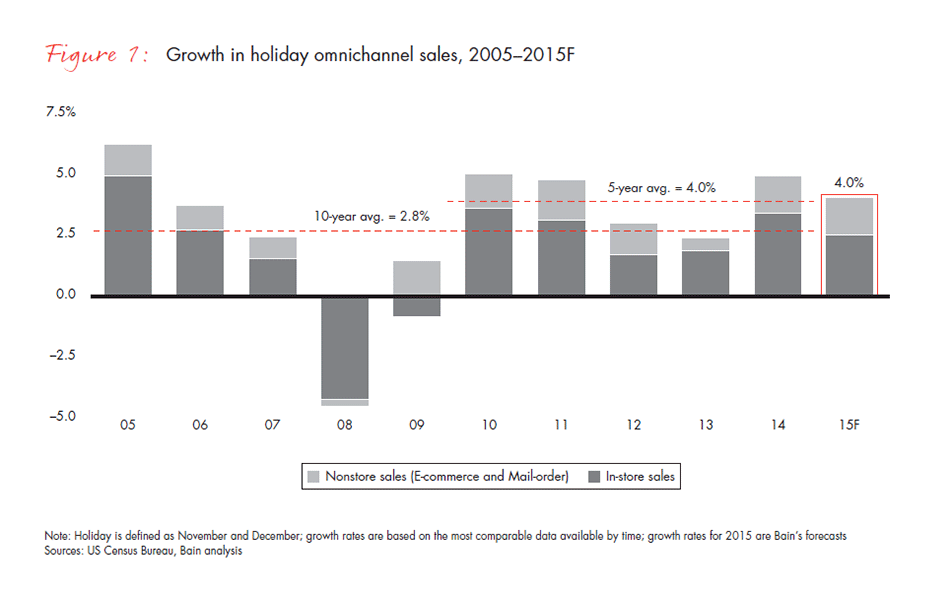
In-store retail sales are critical to the holiday season and are expected to comprise 90% of total sales. Bain forecasts in-store sales growth of 3%, just below the five-year average of 3.2%. E-commerce has shown strong momentum year to date, and we expect this momentum will continue through the fourth quarter, with growth of 13% to close the year.
Macroeconomic indicators support our outlook for a healthy holiday season. More people are working, wages are up and gas prices are low. All bode well for spending, particularly from lower-income households that have been under the greatest financial pressure in recent years. Questions remain, however, about consumers’ willingness to spend on traditional holiday categories and about the impact of recent market volatility on more-affluent households’ spending (Figure 2).
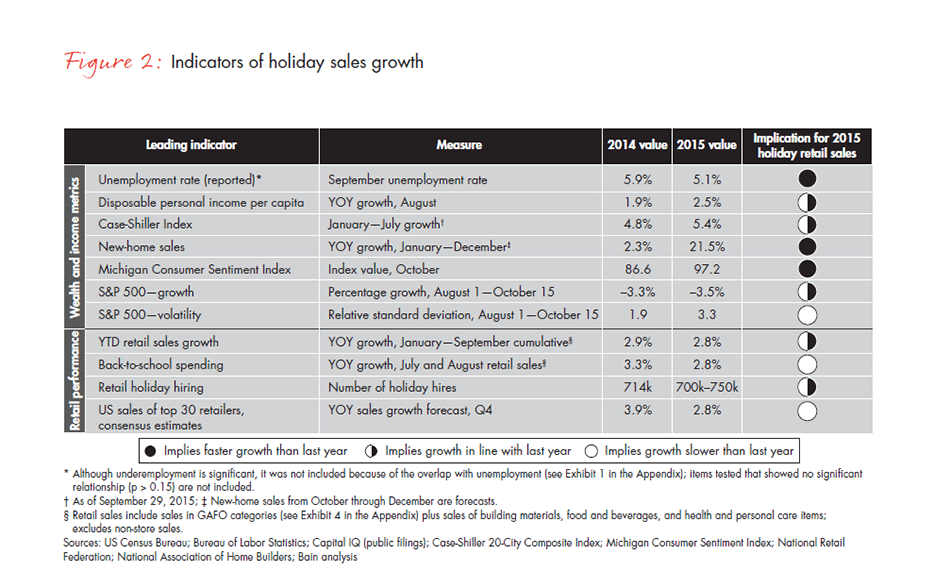
Several factors support our positive holiday outlook:
- There’s more money in more pockets. With the US economy nearing full employment and growth in the median wage, we can expect a 4.5% increase in take-home pay this year.2 In addition, gas prices have stayed below $3 since November 2014. As consumers—particularly those from lower-income households—gain confidence that prices at the pump will remain low, we expect them to spend more. Renewed strength in the housing market is another positive sign for consumers’ psyches and wallets, particularly those from middle-income or aspirational households with a significant percentage of wealth tied up in housing assets. Home owners’ equity is close to pre-recession levels; mortgage debt service ratios haven’t been this low in 34 years; and new-home sales are forecast to go up 21.5% this year.
- Morale is strong. This year Bain partnered with Vision Critical to ask shoppers “How are you feeling about your finances headed into the holiday season?”3 More than 75% of respondents answered “great” or “OK.”4 For households earning more than $50,000 a year, the rate rose to nearly 90%. The Michigan Consumer Sentiment Index and The Conference Board’s Consumer Confidence Index also suggest optimism: Both indexes are at their highest average since 2007.
- The outlook for 2016 is positive. Bain’s Macro Trends Group expects US consumer spending to gain momentum in 2016, driven by stabilized growth in GDP, steady improvement in household finances and increasingly favorable demographics. Historical data indicate a solid correlation between holiday sales growth and the following year’s sales performance (Figure 3). A healthy outlook for 2016, then, should mean healthy sales this November and December.
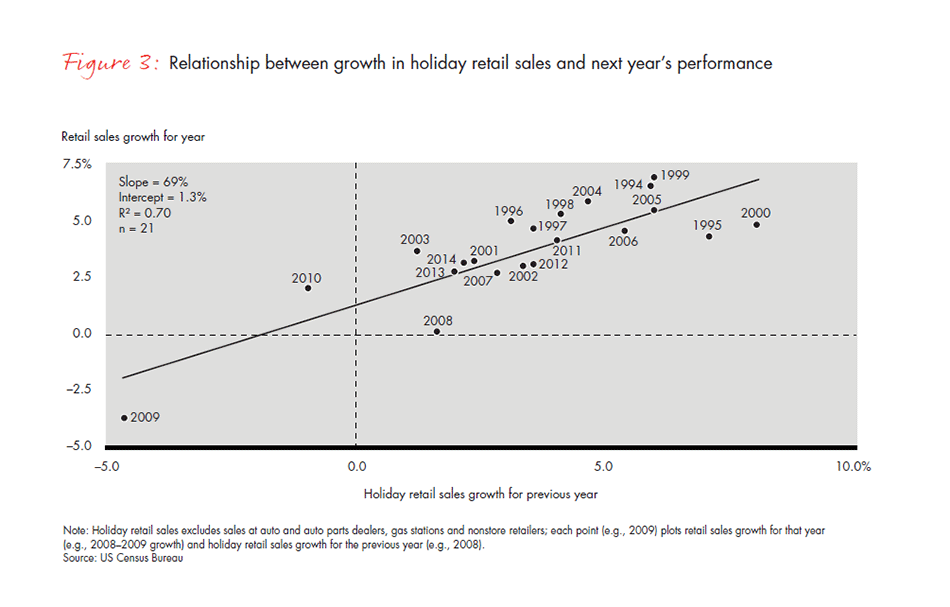
Still, we don’t expect unbridled growth this year. A number of factors are tempering our forecast:
- A shift in spending. This year consumers are spending more on eating out (8.5% growth) and on their cars (7.3% growth). For every $1 spent on traditional retail purchases, they are spending $0.70 on food services and motor vehicles. Given the size of these sectors, this trend has likely impacted growth of traditional retail sales, as evidenced by slower growth in back-to-school (2.8% growth versus 3.3% last year). Several of the factors contributing to this shift—extra gas money, low interest rates and an aging auto fleet—likely will continue through the holiday season.
- Volatile financial markets. The S&P 500 Index is tracking close to where it was tracking at this time last year. However, apprehension over global growth, uncertainty about the Federal Reserve’s plans and a looming budget fight in Congress have increased volatility in the market in recent months and led to a downward trajectory. Ongoing market instability may reduce holiday spending in households earning more than $100,000 a year, households that hold as much as two-thirds of their wealth in financial assets.
- Lower prices on durables. In the year-over-year (YOY) period measured in April 2015, durable goods inflation was down 2.2%; it was up 1.2% for nondurables. This trend may well manifest in lower holiday prices across durable goods categories this season, particularly electronics, dampening nominal growth values.
Unwrapping the holiday sales forecast
Bain’s holiday sales forecast offers a cross-sector view of expected retail performance in November and December. We encourage you to use it to see how financial targets and operational plans are tracking with broader market expectations. That being said, there is certainly wide variation in holiday sales growth by retail sector and store format. In 2014, for example, in-store retail sales increased by 4%, but the range of growth across sectors was 2.2% at the lower end (general merchandise stores) to 6.9% (health and personal care stores) and 7.3% (building materials and garden equipment and supplies dealers) at the higher end (Figure 4). Within the general merchandise sector, which is the largest NAICS category, department store sales fell marginally (down 0.4%), while sales at warehouse clubs and supercenters grew by 3.1%. Headline forecasts mask this variation sector by sector and year over year, and point to the importance of de-averaging to set relevant benchmarks.
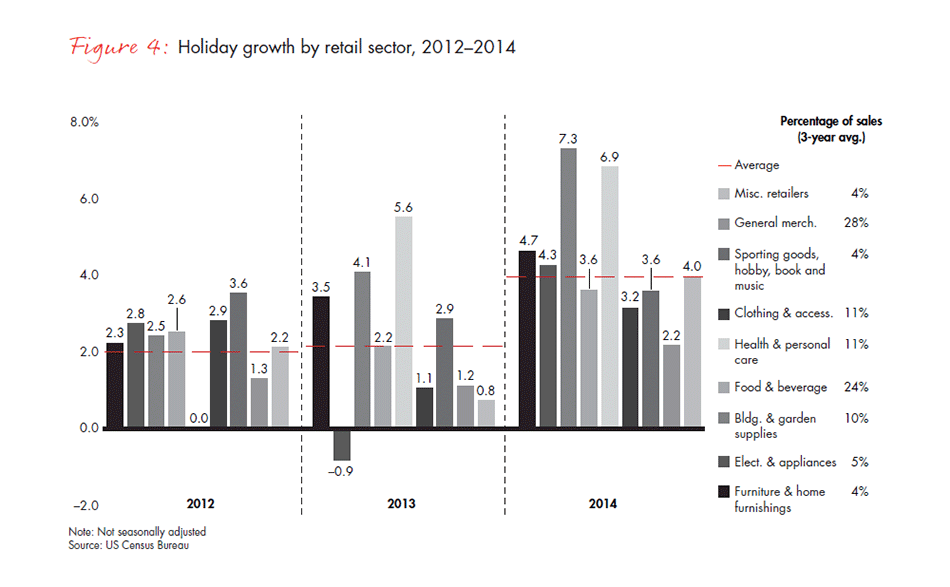
The real gift of a holiday forecast
Let’s face it. By the end of October, a forecast of November and December sales isn’t likely to change retailers’ actions. The merchandise is purchased and on its way. Planograms are set. Hiring plans are locked. For many, our forecast will do little more than increase confidence in or anxiety about plans that are already being implemented.
That would be a shame.
The real value of this newsletter is not in the forecast but in helping retailers learn how to improve forecasting. As we examine our own holiday forecasts over the last 10 years, we find statistically significant improvements in our accuracy. That’s because we scrutinize our errors. We have broadened the variables we analyze (see Figure 2). We have changed their weights. We objectively study more data and expert opinions on all sides of each variable. We’re learning.
This is the time of year when most retailers are building three-year plans and setting operating budgets for 2016, which means they are setting goals. The debate rages: Do they set goals they know they can achieve, or do they stretch toward goals that seem out of reach? It turns out that people with a low need for achievement gravitate toward both extremes. Their fear of failure drives them to choose goals that are either so easy that failure is nearly impossible or so difficult that it’s easy to explain why nobody could possibly have reached them. But people with a high need for achievement—those who do most of the work anyway—want realistic targets. They aren’t motivated by goals that are either certain or impossible to achieve. Their level of motivation and effort rises until the expectation of success is around 50%, and then it begins to fall.
Holiday sales forecasts provide an important opportunity for learning. Our hope is that you will read as many forecasts as possible and make your own predictions. What do you really expect to happen? Why? Which variables will be the most important drivers? How will each variable behave? What should this mean for your three-year plan? And what if you’re wrong? Retailers who push this kind of thinking are more likely to see their performance improve.
Does the early bird get the “gift-wrapped” worm?
If it feels like the holiday shopping season starts earlier every year, that’s because it does. But Round 1 is mostly a battle for market share, not fuel for early volume gain. Walmart appears to have led the charge this year, announcing its 2015 top holiday toy list and layaway program at the end of August, a full two weeks earlier than it announced its list and program in 2014. Kmart gets credit again this year for being the first retailer to televise its holiday offerings, launching a TV ad campaign on September 1 to promote its own layaway program. On September 9, Toys “R” Us kicked off its holiday shipping promotion, cutting its threshold from $49 to $19, strategically below Target’s current threshold of $25, Amazon.com’s $35 and Walmart’s $50. Finally, Target rolled out its permanent online price-matching program on October 1, arming itself for the holiday battle to come.
Are consumers taking the bait?
To answer that question, we analyzed trends in monthly GAFO sales over the last 10 years.5 We expected to find an increasingly higher concentration of sales in September and October, ahead of the traditional holiday period. Instead we found very little change in sales composition by month over time. It seems early holiday chatter may impact where people spend but has minimal impact on when they choose to do so.
To test our findings further, we asked our Vision Critical survey participants when they expected to start their holiday shopping this year relative to last year. Sure enough, more than 80% of respondents were planning to shop when they did last year, or even later. Of those who planned to jump-start the season, nearly half identified themselves as “early birds,” people who work hard to get their holiday shopping done early every year.
Staying informed this holiday season
Over the next 12 weeks, we’ll be tracking holiday trends, innovations and market results, and we look forward to sharing an additional four newsletters with you. This year, we’ll continue working with Vision Critical and follow a group of consumers along their holiday shopping journey, starting next week through the lead up to Christmas. We’ll also be watching closely to see what Amazon has in store, how consumers’ perceptions of the retail giant stack up to reality and how other retailers are tapping into the benefits of their physical store networks.
Here’s a preview of our upcoming holiday issues:
- Issue #2 (mid-November): ’Tis the season for free shipping
- Issue #3 (early December): Half-time report and all eyes on Amazon
- Issue #4 (mid-December): Digical® retail and why stores matter
- Issue #5 (late January): Holiday recap and 2016 outlook
Please let us know if you have specific topics you would like to learn more about. We look forward to sharing holiday headlines and hearing from you throughout the season.
Appendix
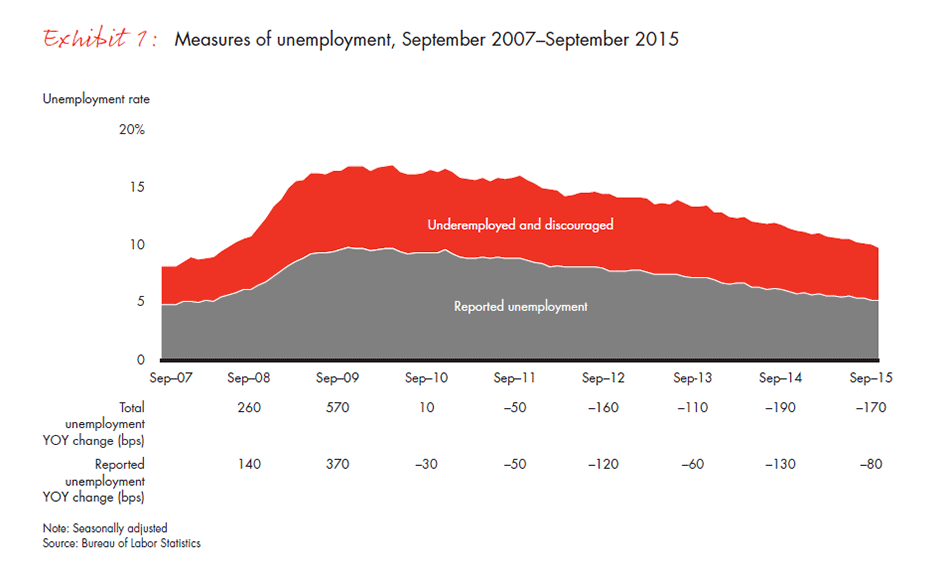
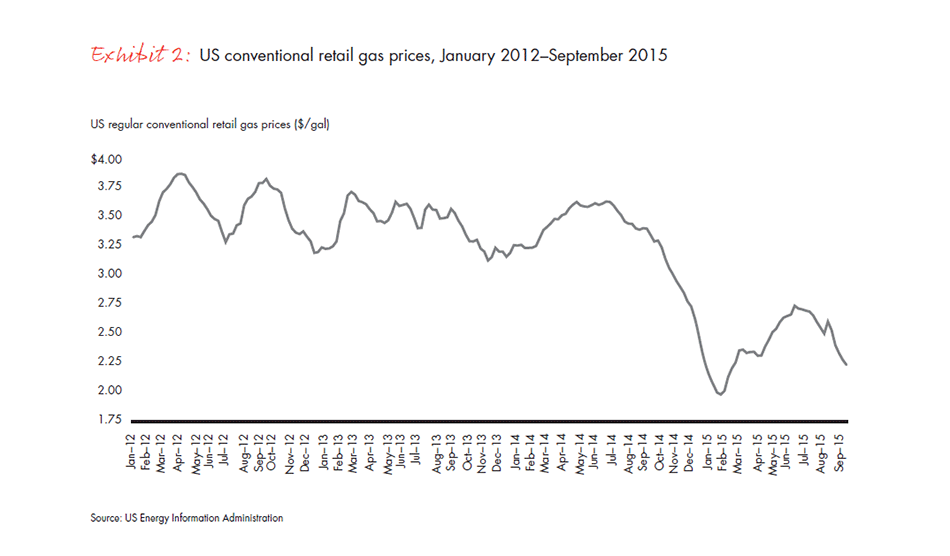
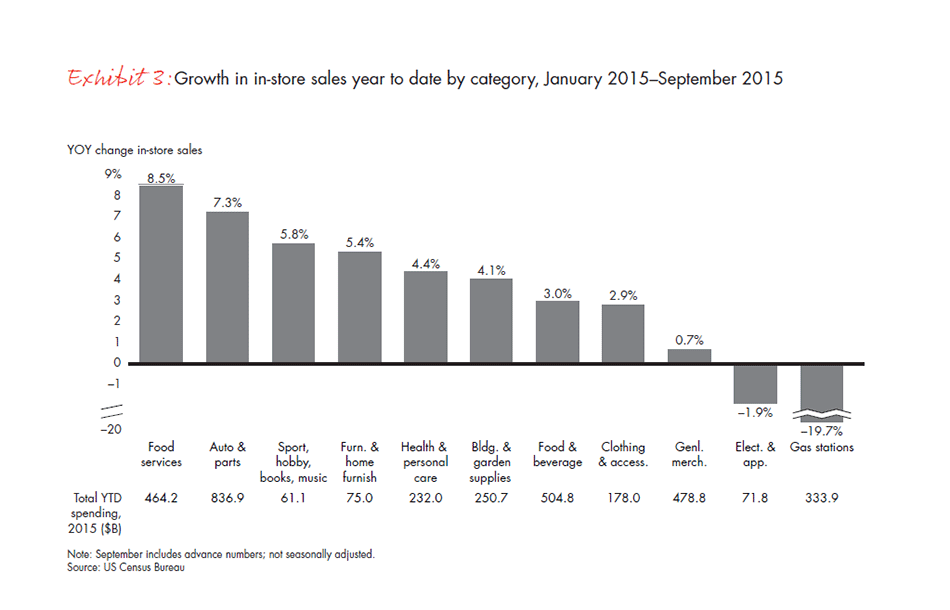
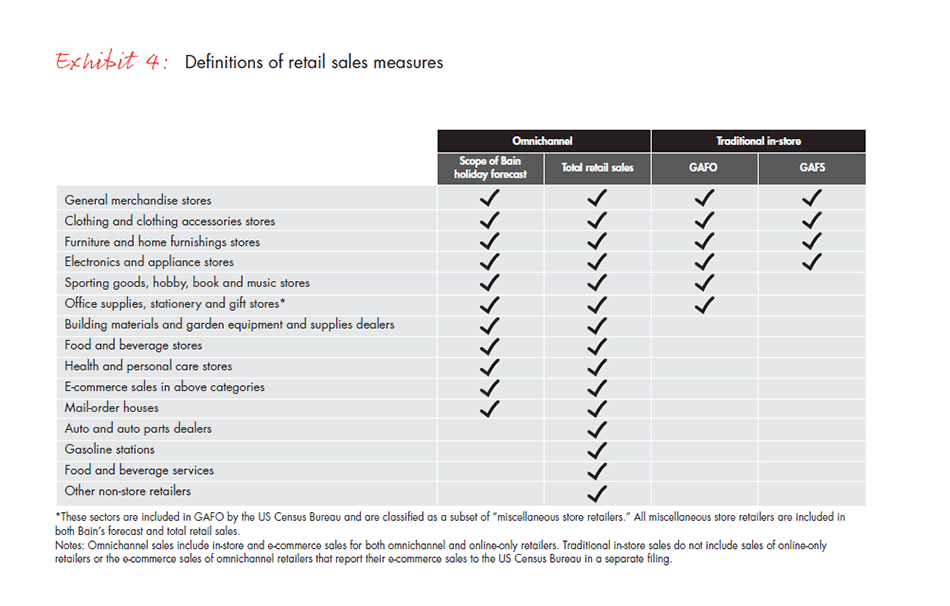
View the full PDF for a list of references
1 Holiday retail sales include North American Industry Classification System (NAICS) categories 442 (furniture and home furnishings stores), 443 (electronics and appliance stores), 444 (building materials and garden equipment and supplies dealers), 445 (food and beverage stores), 446 (health and personal care stores), 448 (clothing and clothing accessories stores), 451 (sporting goods, hobby, book and music stores), 452 (general merchandise stores) and 453 (miscellaneous store retailers), and e-commerce and mail-order sales across these categories.
2 The take-home pay increase is based on the Bureau of Labor Statistics’ data on growth in nonfarm payroll and growth in average weekly earnings of nonfarm payroll.
3 Vision Critical provides a cloud-based customer intelligence platform that allows companies to build engaged, secure communities of customers they can use continuously, across the enterprise, for ongoing, real-time feedback and insight. Vision Critical’s Consumer, Retail, & Shopper Insights Consulting Practice surveyed 1,007 Americans from its proprietary national community, Springboard America, to provide insight into holiday shopping behavior.
4 Results were weighted by geography, gender, age, education and household income.
5 GAFO sales include sales at general merchandise stores; clothing and clothing accessories stores; furniture and home furnishings stores; electronics and appliance stores; sporting goods, hobby, book and music stores; and office supplies, stationery and gift stores. See Exhibit 4 in the Appendix for definitions of GAFO and other sales measures. Our analysis focused on the sectors most impacted by holiday sales.
Digical® is a registered trademark of Bain & Company.







